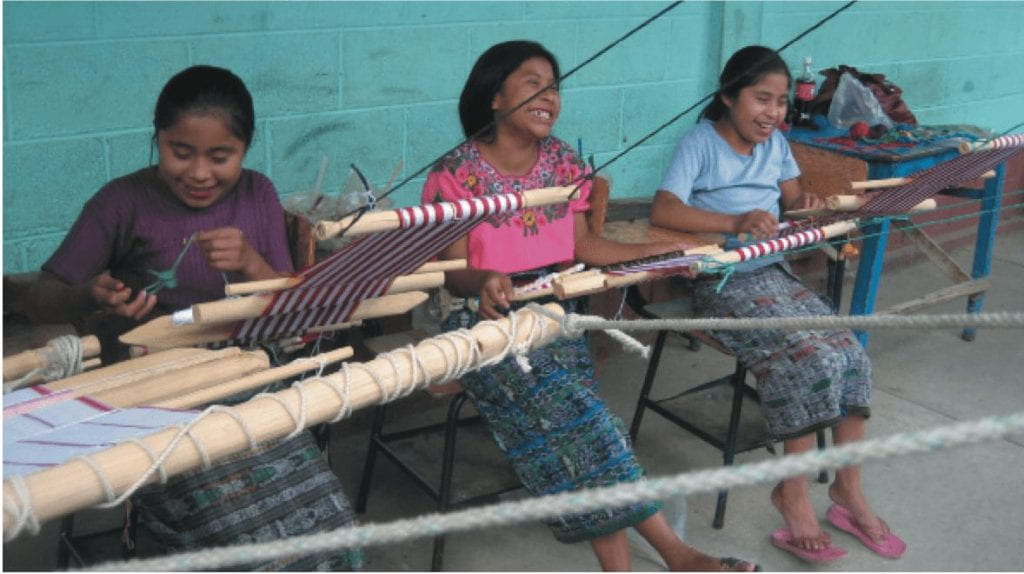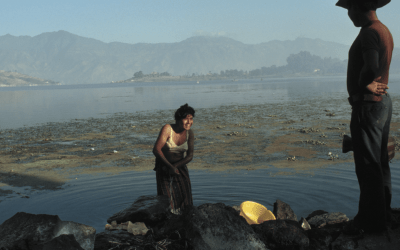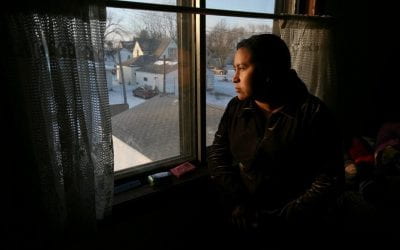Revitalizing Mayan Textiles
An Ixchel Museum Educational Program
What satisfaction could be greater than the joy of sharing the completion of one’s first weaving? None! This pleasure is even greater when the weaver is a young boy or girl, facing for the first time the challenge of knowing when to tighten, loosen or stop; when to breathe deeply and disentangle some threads on the verge of becoming a knot. Through maturity and experience, expert weavers handle these situations easily enough, not only in weaving but in life as well. Much of living can be learned through weaving!
For more than 2,000 years, the communities in the highlands of Guatemala have passed down orally the tradition of weaving from generation to generation. In the Maya villages of Mesoamerica, weaving was a feminine activity associated with fertility; fertility and weaving even shared a goddess, Ixchel. Today, the craft of weaving has changed a lot, not only when it comes to the use of the traditional indigenous garments, but also because of new materials, designs, and technology. And today, even men weave.
The way of transmitting this ancestral knowledge is slowly being lost, however. Mothers would rather have their daughters go to school and study some modern profession, leaving the looms, stored away and triste (sad, as the grandmothers say when a loom is not being used). When they say triste, they mean the empty space that not weaving leaves, because through weaving they teach values as well as ways of thinking and feeling. Working the backstrap loom seems to them to reaffirm the identity of the Maya people, relive their culture, and maintain in the present the ancient language of the weavings.
For more than 35 years, all this richness has been studied in the textiles in the collection of the Ixchel Museum, where more than 3,000 pieces speak to us of the daily life, rituals and other aspects of the Maya culture. We have been entrusted with disseminating this cultural knowledge, and our work is shown in the permanent, temporary, traveling, and interactive exhibitions of the museum.
Because of the urgency caused by the growing loss of ancestral knowledge and thus of identity, we sought a more direct way to return this cultural heritage to the communities in which it originated. As a result, in 2002, a grant from the Inter-American Development Bank (IDB) allowed us to launch the Textile Tradition Revitalization Program. Giving priority to the high plateau communities where the textile tradition is seen as being at high risk, the idea is to set up a system of apprenticeship for the craft and to incorporate knowledge about weaving textiles into the national education system. With a focus on teaching, this approach frames weaving in terms of national cultural patrimony and sets it up as an important matter in the diversity of Guatemalan society. Groups of children between 11 and 13 years of age learn about textile weaving, with instruction adapted as needed for each community. With the constant support of the museum, teachers have committed themselves to following students for the length of the school year, using select teaching materials, making visits to the Ixchel Museum in Guatemala City and maintaining direct contact with a master weaver in the area. This experience is complemented by dynamic discussion workshops, awareness and sensitization, all to achieve the appreciation of Maya culture through the weaving tradition and specifically through textiles as works of art.
Nine years later, the Revitalization Program has become enormously enriched with the contributions of each community in which it takes place. The results are palpable. The program has reestablished generational bridges, it has fortified the identities of children, their families, and their teachers, and above all, it has managed to present weavings as transcending purely economic importance and approaching a dimension that is human, aesthetic, and cultural. The representation of all this is the last exhibit in the galleries of the museum, where participants in the program created each textile on display.
Programa de revitalización textil Maya de Guatemala
Museo Ixchel del Traje Indígena
By Fabiana Flores Maselli
¿Qué satisfacción puede ser mayor que la alegría de compartir el haber terminado el primer tejido? ¡Ninguna! Ese gozo es mayor cuando el tejedor es un niño o una niña de corta edad y se enfrenta por primera vez al reto de saber cuándo tensar, aflojar, o detenerse: respirar profundo y desenredar unos hilos que están a punto de convertirse en un nudo. Por madurez y experiencia, las tejedoras expertas manejan estas situaciones con bastante facilidad. No sólo en el telar sino también en la vida… ¡Cuánto del vivir se aprende en el telar!
Desde hace más de dos mil años, en las comunidades del altiplano de Guatemala, la tradición textil se transmitía oralmente de generación en generación. En los pueblos mayas de Mesoamérica, era una actividad femenina asociada a la fecundidad; hasta compartían una misma deidad llamada Ixchel. Ahora, la realidad del tejido ha cambiado notablemente, no sólo en cuanto al uso del traje indígena tradicional, sino también por los materiales, diseños y tecnología utilizada. ¡Hoy, los hombres también tejen!
La forma de transmitir este conocimiento ancestral va quedando en el olvido. Las madres prefieren que sus hijas asistan a la escuela y estudien alguna profesión productiva, dejando los telares de las abuelas guardados y ¨tristes¨ (como dicen ellas cuando un telar no se usa). Pero cuando dicen ¨tristes¨ se refieren más al vacío que deja el no tejer, pues, a través del tejido, se enseñan valores, formas de sentir y de pensar. Tejer en el telar de cintura permite reafirmar la identidad de los pueblos mayas, actualizar su cultura y mantener en el presente el lenguaje antiguo de los tejidos.
Toda esa riqueza, estudiada por más de treinta y cinco años en los tejidos de la colección del Museo Ixchel, donde más de tres mil piezas nos hablan de la vida cotidiana, ceremonial y otros aspectos de la cultura maya, nos ha comprometido a difundir este conocimiento. Muestra de ese trabajo son las exposiciones: permanentes, temporales, itinerantes e interactiva.
La urgencia determinada por la creciente pérdida del conocimiento ancestral, y por consiguiente de identidad, nos ha obligado a buscar una manera más directa de regresar dicho patrimonio a las comunidades que le dieron origen. Así, en el año 2002, un grant recibido del Banco Interamericano de Desarrollo (BID) permitió iniciar el Programa de Revitalización de la Tradición Textil. Dando prioridad a las comunidades del altiplano donde la tradición textil se ve en alto riesgo, la metodología escogida ha sido la sistematización del aprendizaje y su incorporación al sistema de educación nacional. Con enfoque didáctico, el tejido se enmarca dentro de los aspectos del patrimonio nacional y se contextualiza como un tema importante en la diversidad de la sociedad guatemalteca. El proceso se realiza con grupos de niños y niñas entre once y trece años y se adecúa con sutiles variantes a cada comunidad. Con apoyo constante del Museo, los maestros se comprometen a darle seguimiento a lo largo del año escolar, utilizando para ello, material didáctico específico, efectuando visitas al Museo Ixchel en la Ciudad de Guatemala y manteniendo el contacto directo con una tejedora experta de la localidad. Esta experiencia se complementa con talleres dinámicos de discusión, concientización y sensibilización, todo para lograr la valoración de la cultura maya a través de la tradición textil y específicamente de los tejidos como obras de arte.
Nueve años después, el Programa de Revitalización se ha enriquecido enormemente con el aporte de cada comunidad donde se ha realizado. Los resultados son palpables. Se han reestablecido puentes generacionales, se ha fortalecido la identidad de los niños y niñas, de sus familias, de sus maestros, y sobre todo, se ha logrado que los tejidos trasciendan el aspecto puramente económico y alcancen una dimensión humana, estética y cultural. Muestra de todo ello es la exposición final en las salas del Museo de cada una de las obras textiles realizadas por los participantes.
Related Articles
Guatemala: Editor’s Letter
The diminutive indigenous woman in her bright embroidered blouse waited proudly for her grandson to receive his engineering degree. His mother, also dressed in a traditional flowery blouse—a huipil, took photos with a top-of-the-line digital camera.
Making of the Modern: An Architectural Photoessay by Peter Giesemann
Making of the Modern An Architectural Photoessay by Peter Giesemann Fall 2010 | Winter 2011, Volume X, Number 1Related Articles
Increasing the Visibility of Guatemalan Immigrants
Guatemalans have been migrating to the United States in large numbers since the late 1970s, but were not highly visible to the U.S. public as Guatemalans. That changed on May 12, 2008, when agents of Immigration and Customs Enforcement (ICE) launched the largest single-site workplace raid against undocumented immigrant workers up to that time. As helicopters circled overhead, ICE agents rounded up and arrested …




